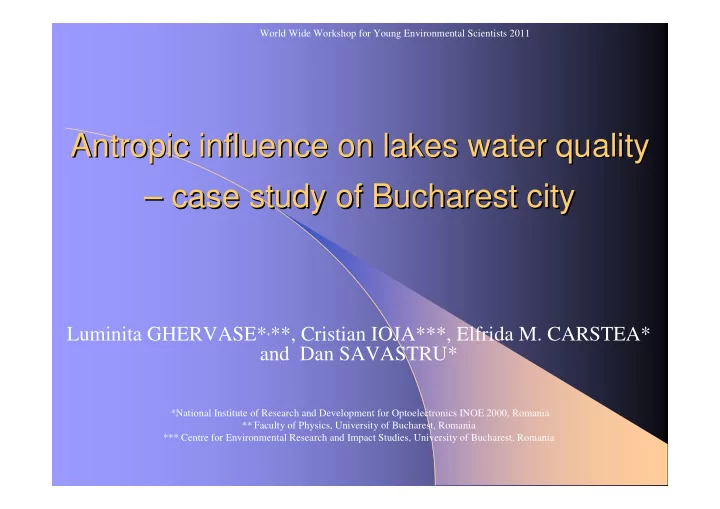

World Wide Workshop for Young Environmental Scientists 2011 Antropic influence on lakes water quality Antropic influence on lakes water quality – case study of Bucharest city case study of Bucharest city – Luminita GHERVASE* , **, Cristian IOJA***, Elfrida M. CARSTEA* and Dan SAVASTRU* *National Institute of Research and Development for Optoelectronics INOE 2000, Romania ** Faculty of Physics, University of Bucharest, Romania *** Centre for Environmental Research and Impact Studies, University of Bucharest, Romania
Aim Aim • Describe the quality of Bucharest lakes, based, for the first time, on the comparison of standard and fluorescence measurements.
Sampling Sampling Map with sampling locations
Physico chemical measurements Physico chemical measurements Sampling campaign May – June 2010 • Dissolved oxygen • Ammonia content • Chemical oxygen demand • Nitrates • Fluorescence spectroscopy
Water fluorescence Water fluorescence 400.00 1000 Protein-like 963.01 fluorescence 375.00 889.03 800 815.05 350.00 W aveleng th (nm ) 741.07 C 667.08 Intensity (a.u.) 325.00 600 593.10 M Tryptophan (T): 300.00 519.12 λ ex : 230-290 nm T 1 445.14 400 λ em : 320-350 nm 275.00 371.16 297.18 250.00 200 Tyrosine (B): 223.20 A λ ex = 230-280 nm T 2 149.21 225.00 B λ em = 300-320 nm 75.23 0 200.00 1.25 300 350 400 450 500 300.00 325.00 350.00 375.00 400.00 425.00 450.00 475.00 500.00 W avelength (nm ) Wavelength (nm) Humic-like Humic acids (A): Fulvic acids (C): Recent production (M) λ ex = 230-260 nm λ ex = 330-360 nm λ ex = 310-320 nm fluorescence λ em = 380-480 nm λ em = 380-480 nm λ em = 380-420 nm
Results and discussions Results and discussions 10 25 Dissolved oxygen (mg/l) 20 Nitrates (mg/l) 8 15 10 6 5 0 P1 P2 P3 P4 P5 P6 P7 P8 P9 P10 P11 P12 P13 P14 P15 P16 P1 P2 P3 P4 P5 P6 P7 P8 P9 P10 P11 P12 P13 P14 P15 P16 40 5 Ammonia (mg/l) 4 COD (mg/l) 30 3 2 20 1 0 P1 P2 P3 P4 P5 P6 P7 P8 P9 P10 P11 P12 P13 P14 P15 P16 P1 P2 P3 P4 P5 P6 P7 P8 P9 P10 P11 P12 P13 P14 P15 P16 W ater samples Standard chemical parameters of the lake water samples
Results and discussions Results and discussions 4 3.0x10 5 7.1x10 C A 4 λ ex =340 nm 2.9x10 λ ex =260 nm 5 7.1x10 4 2.9x10 5 1.0x10 4 2x10 Fluorescence intensity (a.u.) 4 5.0x10 4 1x10 P1 P2 P3 P4 P5 P6 P7 P8 P9 P10 P11 P12 P13 P14 P15 P16 P1 P2 P3 P4 P5 P6 P7 P8 P9 P10 P11 P12 P13 P14 P15 P16 4 3.0x10 5 M 1x10 T - B λ ex =310 nm 4 λ ex =280 nm 2.5x10 5 1x10 4 2.0x10 5 1x10 4 1.5x10 4 5.00x10 4 1.0x10 4 2.50x10 3 5.0x10 P1 P2 P3 P4 P5 P6 P7 P8 P9 P10 P11 P12 P13 P14 P15 P16 P1 P2 P3 P4 P5 P6 P7 P8 P9 P10 P11 P12 P13 P14 P15 P16 Water samples Principal fluorophores
Results and discussions Results and discussions • HIX: 0.59 to 2.48 � bacterial ∑ ∑ = HIX F / F → → 435 480 300 345 organic matter, of autochthonous λ = 254 nm ex origin and less DOM humification degree � • BIX: 0.76 and 1.31 = BIX F / F 380 430 predominantly autochthonous origin λ = 310 nm ex of DOM and organic matter freshly released into water = FI F / F • FI ~ 1.24-1.39 � mixture of allochthonous 450 500 λ = and autochthonous organic matter 370 nm ex
Results and discussions Results and discussions 4 1.6x10 Fluorescence intensity (a.u.) 4 1.2x10 3 8.0x10 3 4.0x10 P1 P2 P3 P4 P5 P6 P7 P8 P9 P10P11P12 P13P14P15P16 Water samples Chlorophyll – a levels in the urban lentic systems
Conclusions Conclusions � Important microbial content found in all lakes, coming from water degradation sources � Fluorescence indices showed the presence of bacterial organic matter, of predominantly autochthonous origin, with very low DOM humification degree. � Ecological status influenced by individual residential areas in lakes proximity � Good correlation with standard parameters
Thank your Thank your for your attention! for your attention! The financial support for this study has been provided by Romanian National Program CNMP, project no. 92–104/01.10.2008, “Environmental management in urban residential spaces in the framework of current climate changes – ECOLOC”.
Recommend
More recommend